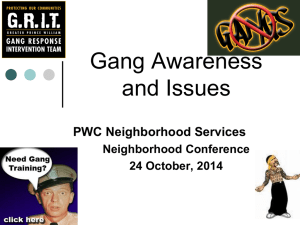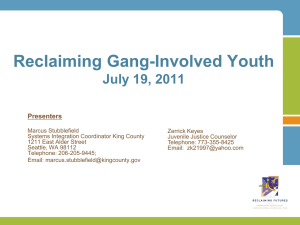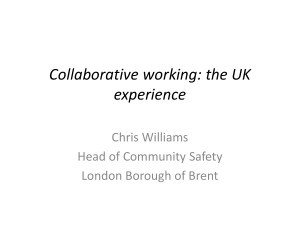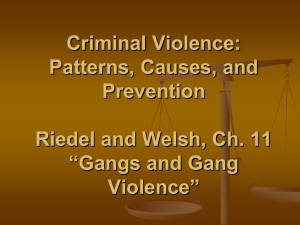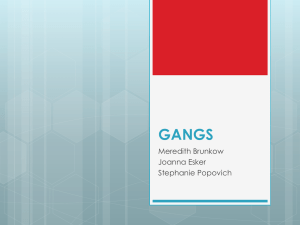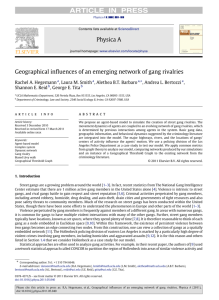Agent Based Models for Gang Rivalries
advertisement
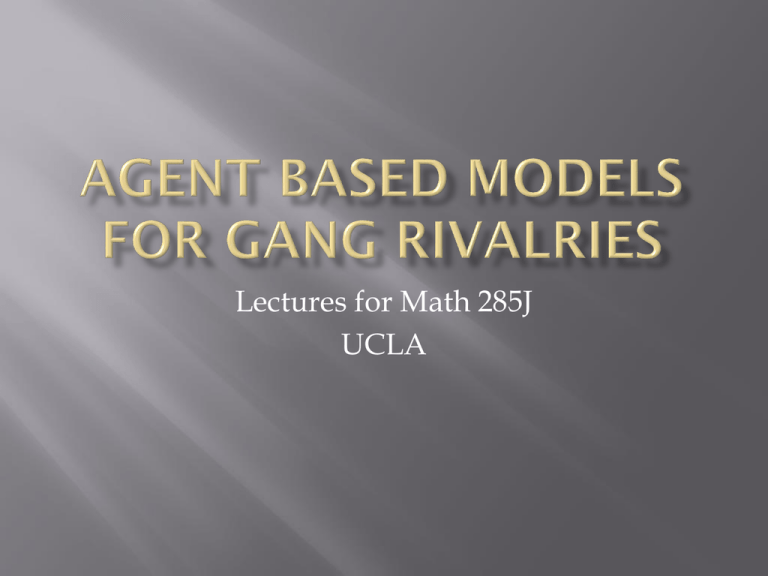
Lectures for Math 285J UCLA R. A. Hegemann, L. M. Smith, A. Barbaro, A. L. Bertozzi, S. Reid, and G. E. Tita, Geographical influences of an emerging network of gang rivalries, Physica A, Volume 390, Issues 21-22, 15 October 2011, Pages 3894-3914 Laura M. Smith, Andrea L. Bertozzi, P. Jeffrey Brantingham, George E. Tita, and Matthew Valasik, Adaptation of an Ecological Territorial Model to Street Gang Spatial Patterns in Los Angeles Discrete and Continuous Dynamical Systems A, 32(9), pp. 3223 3244, 2012. Laura Smith, PhD Thesis, UCLA, 2012 Incorporating Spatial Information into Density Estimates and Street Gang Models. G. Tita, K. Riley, G. Ridgeway, C. Grammich, A. Abrahamse, P. Greenwood, Reducing gun violence: Results from an intervention in East Los Angeles,Natl. Inst. Justice, RAND (2003). G. Tita, J. Cohen, J. Engberg, An ecological study of the location of gang set space, Soc. Probl. 52 (2) (2005) 272–299. Rivalry network among 29 street gangs in Hollenbeck, Los Angeles Tita et al. (2003) Some gangs have been around since before World War II Retaliatory violence is common Gangs tend to mark their “turf” by using graffiti Rivalries in Hollenbeck tend to be driven by territorial issues Gang activity in Hollenbeck is generally isolated from gang activity outside of Hollenbeck Makes for an excellent testbed for development of models and algorithms. 29 Active Gangs in Hollenbeck 69 Rivalries Among the Gangs A Set Space is a gang’s center of activity where of activity where gang member spend a large quantity of their time Freeways and other geographic features influence the rivalry network S. Radil, C. Flint, and G. Tita,“Spatializing Social Networks: Using Social Network Analysis to Investigate Geographies of Gang Rivalry, Territoriality, and Violence in Los Angeles.” 2010. Statistical modeling of gang violence in Los Angeles – SIURO 2010 Egesdal, Fathauer, Louie, and Neumann. Each agent targets a gang with a probability based on the current rivalry strengths. This target is kept for the lifetime of the agent. The agent moves on a lattice from one location to the next based on calculated probabilities. These probabilities depend on the location of the agents target gang members and the target’s gang “anchor point” or set space. The set space for each gang was determined from the locations of criminal events involving the gang. After all the agents have moved, new gang members are added with a certain rate When agents of different gangs occupy the same cell, they fight with a probability based on the rivalry strength. If two agents fight, they leave the simulation. The rivalry strength is increased in proportion to the number of fights between gang members and decreased with time. From Metzler and Klafter, 2000. PDF for Brownian walk in 1D: Using Taylor expansions in space and time and passing to the limit one gets Propagator: Fourier transform Fickian diffusion has certain statistics, in particular <x2(t)>~Kt, characteristic of Brownian motion. Sub-diffusion has different scaling <x2(t)>~Kata and occurs in many systems. This is the case where jump lengths are the same but one can have a waiting time between jumps that has a long tail distribution. Levy process occurs when the jump length is taken from a long-tailed distribution however the waiting times are normally distributed. In this case the variance is infinite and one has to look to other statistics to define the Levy behavior. Brownian(le ft) Levy (right) Length of jump as well as waiting time between jumps are drawn from PDF. Levy has jump length PDF m>0 Propagator satisfies the nonlocal PDE Where the nonlocal operator is easily expressed in terms of its Fourier transform: G.M. Viswanathan et al, Nature 401, 911 (1999). Searching for unknown target locations Efficiency of search can be defined as number of targets visited compared to typical distance travelled. For destructive searches (crime applications) one takes m as close to zero as possible. For non-destructive searches the optimal m is close to 1, with a margin that behaves like Here l is avg distance between targets and rv is the vision distance. Graph Generating Methods May produce a reasonable approximation to the observed network Other phenomena of interest beyond the structure of the network will not be obtained from this type of model Agent-Based Methods Easily incorporates environmental and spatial information inherent to the system Allows for exploring how changing the dynamics of the individual agents or the environment can affect the evolution of the network Movement Dynamics: Agents move according to Brownian Motion Agents have some probablity of crossing a boundar (major roads, freeways, and the Los Angeles River) Interactions: If two gang members from different gangs cross paths, then an interaction has occurred At the end of the simulation, we exclude rivalries where the number of interactions is mutually insignificant to both gangs There is compelling evidence in the literature that when people move in an unconstrained environment, the jump lengths between movements is distributed like a power law In the presence of obstacles such as roads and buildings, the jump lengths more accurately follow a bounded power law distribution People frequent certain locations (home, work, etc.) Gang members avoid rival gangs’ territories D. Brockmann, L. Hufnagel, and T. Geisel. The scaling laws of human travel. Nature, 439:462-465, 2006. I. Rhee, M. Shin, S. Hong, K. Lee, and S. Chong. On the lévy-walk nature of human mobility: Do humans walk like monkeys? In IEEE INFOCOM 2008 - IEEE Conference on Computer Communications, pages 924-932. IEEE, April 2008. M. Gonzalez, C. A. Hildalgo, and A.-L. Barabasi. Understanding individual human mobility patterns. Nature Letters, 453:779-782, 2008. Movement Dynamics: Agents are allowed to move in free space according to a biased Lévy walk We choose the direction of bias based on the location of other gangs’ set spaces and the location of the agent’s set Space Agents have some probablity of crossing a boundary Interactions: If two gang members from different gangs cross paths,then an interaction has occurred At the end of the simulation, we exclude rivalries where the number of interactions is mutually insignificant to both gangs Coyotes and wolves have distinct home ranges that are well-established They create scent marks to establish cues for both their own pack as well as other packs They may respond with avoidance to scent marks and move in the direction of their home range center (den site) These animals have territorial patterns Gang members have distinct territories that are well-established They create graffiti to establish cues for both their own gang as well as other gangs They may respond with avoidance to graffiti and move in the direction of their territory’s center (set space) These gang members have territorial patterns The SBLN model performs the best in the accuracy metrics The PDE model does not perform as well The way we constructed the rivalry network limits the connections across the semipermeable boundaries To evaluate the PDE model, we instead consider different data sets


